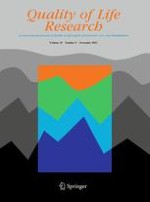01-11-2011
Using the knee-specific Hughston Clinic Questionnaire, EQ-5D and SF-6D following arthroscopic partial meniscectomy surgery: a comparison of psychometric properties
Gepubliceerd in: Quality of Life Research | Uitgave 9/2011
Log in om toegang te krijgenAbstract
Purpose
To compare the psychometric properties of the Hughston Clinic Questionnaire (HCQ), EQ-5D and SF-6D in patients following arthroscopic partial meniscectomy surgery.
Methods
A total of 84 participants (86% men; mean age 40) were recruited. The questionnaires were completed on average 5 days, 6 weeks and 6 months after surgery and compared for internal consistency, convergent validity, sensitivity to change and floor and ceiling effects.
Results
Internally, the HCQ was the most consistent instrument (α = 0.923) followed by the SF-6D and EQ-5D. The EQ-5D and SF-6D were moderately correlated with the HCQ (ρ = 0.499 and 0.394, respectively). Six weeks after surgery, the most sensitive measures were the HCQ and EQ-5D (effect size: 2.04 and 0.99, respectively), at 6 months, with a smaller cohort (n = 42), again it was the HCQ and EQ-5D (effect size: 2.03 and 1.04, respectively). The SF-6D demonstrated no ceiling or floor effect during the study; the HCQ demonstrated a ceiling affect for 5% of respondents at 6 months after surgery compared to 26% of respondents for the EQ-5D.
Conclusion
For this patient population, our findings indicated that the EQ-5D was more consistently responsive to change over time, as a utility index was better at distinguishing differences between groups and reflected the results of the joint-specific HCQ for knee recovery better than the SF-6D. It is therefore recommended that for similar populations, the EQ-5D is preferable to the SF-6D for utilisation alongside the HCQ.
